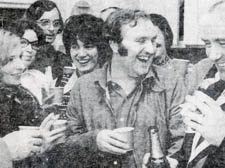|
|
 |
| |
 Beardless Frank Dobson joins in the celebrations after the successful purchase of the Lissenden Gardens flats Beardless Frank Dobson joins in the celebrations after the successful purchase of the Lissenden Gardens flats |
How Gardens estate bloomed into a model community
To Paradise by Way of Gospel Oak. By Rosalind Bayley
Camden History Society
I MUST begin by making a declaration of interest. This history of the Lissenden Gardens estate, next to Parliament Hill, makes favourable references to me.
But that’s not the only reason I can recommend it. Rosalind Bayley’s 100-page history of the first 100 years of the mansion blocks and the people who have lived in them isn’t just a lot of facts about the buildings, though it has a lot of them.
It is full of the social background to the layout and architecture, of the business background of the developer and his family who ran the estate until the 1970s and of the mixed character of the people who have lived there, and still do.
Did you know that mansion flats built a century ago were laid out to minimise the temptations of the flesh by separating bedrooms from living rooms and both from the servants’ quarters? Not so at Lissenden Gardens. Maybe that accounts for the friendly atmosphere.
Besides telling the story of the place and people, Bayley emphasises how she managed to find out so much about what happened over 100 years – a lot of application and a little serendipity went a long way.
Built for renting by the middling middle class, Lissenden Gardens catered for local tradesmen, artists and writers. John Betjeman was born there. Like the rest of our area, it housed people from the locality and also waves of incomers, fleeing persecution and destitution in their homelands, including Jews and others escaping from Nazi Germany.
The landlords, the Armstrong family, were paternalistic in the best sense of the word. They didn’t exploit the tenants and didn’t make a fortune.
They decided to sell up at exactly the time when rapacious private landlordism was at its height – or perhaps depth would be a better word. The new landlords, after a quick killing, wanted to break up the estate by selling flats to sitting tenants or getting them out to sell with vacant possession. In an extraordinary combined display of self-interest and the common good, the tenants banded together to fight off this threat to their homes and their neighbours.
Ros Bayley describes how they went about it. How they pressed Camden Council to buy up the estate, first with a compulsory purchase order and, when that was refused, just by buying out the landlords, who by this time were in financial trouble because the property market was crashing.
They called a protest meeting on the tennis court, as in the French Revolution, at which the new leader of the council, a beardless youth called Frank Dobson, promised we would not take no for an answer and would do everything in our power to protect the tenants.
Combined operations by the tenants, by environmental health officers who kept posting repair notices and by council valuers finally got the new landlords to sell out in October 1973.
The celebrations that followed in one of the flats involved a bath entirely full of champagne bottles and ice. Rather than be left in the hands of private landlords, nearly all the residents were happy to have security of tenure as council tenants. It was much the same with the people who lived in the other 6,000 flats we bought at the time.
The tenants’ association had to continue to stick up for their members, resisting various schemes for massive changes to the flats. And now the estate is a happy place where all sorts of people from mixed and different backgrounds manage to rub along with their neighbours. With people helping one another, not just accepting differences but celebrating them, which is how we must all learn to live, if we want a decent, secure and prosperous future, not just in Camden but right round the world.
So the commitment of the Lissenden Gardens tenants’ leaders, like John Crouch (later a councillor) and Mildred Levinson, backed up by local councillors John Carrier and the late Jean Cox, has paid off.
And there are lessons there for all of us.
The tenants’ association didn’t just make demands on other people. They started by asking themselves, “what can we do?’ and “how do we get others to help us?”
It was such positive campaigning that won the day. For my part, I loved every minute of it.
When I look back I can do no better than repeat the immortal words, “Lawks, what times we had”.
FRANK DOBSON
•
•
|
 |
|
|
 |
 |
|
 |
|
 Beardless Frank Dobson joins in the celebrations after the successful purchase of the Lissenden Gardens flats
Beardless Frank Dobson joins in the celebrations after the successful purchase of the Lissenden Gardens flats
